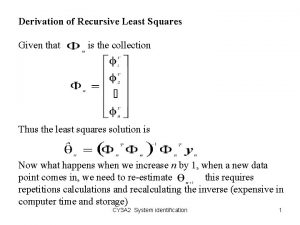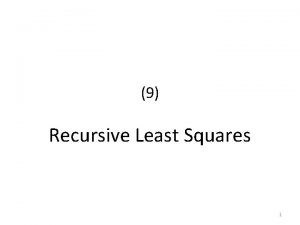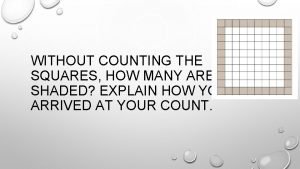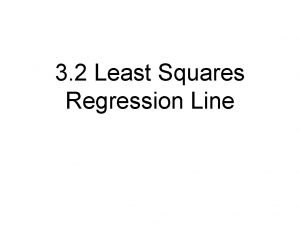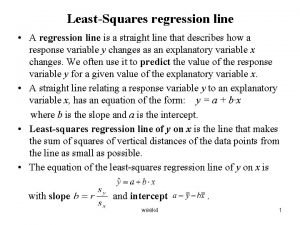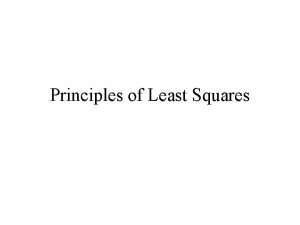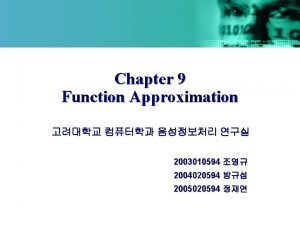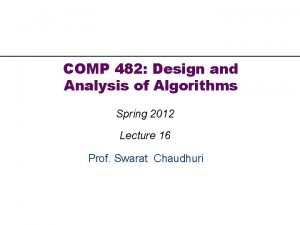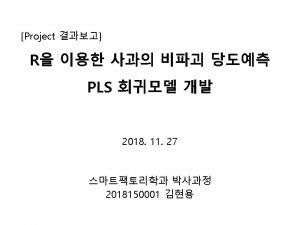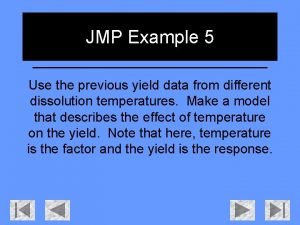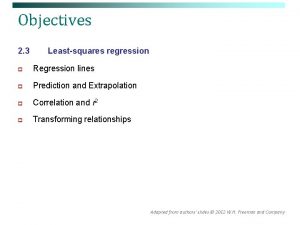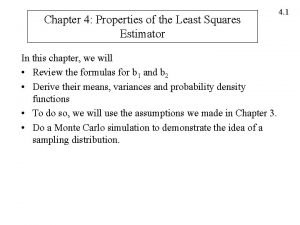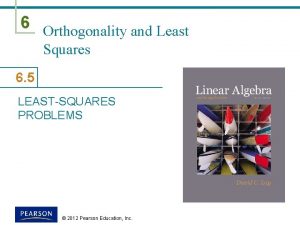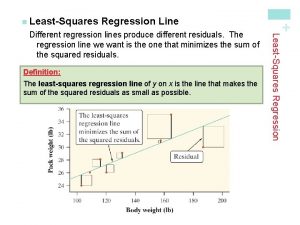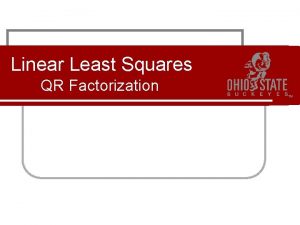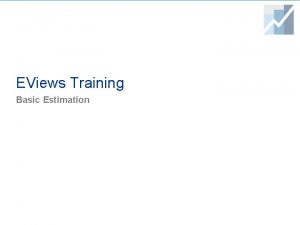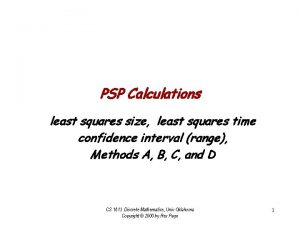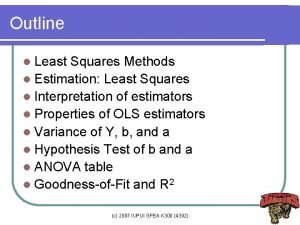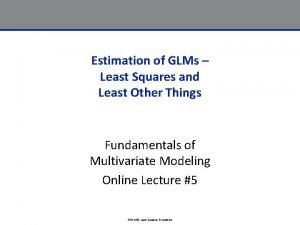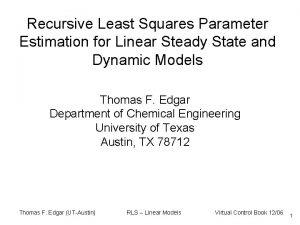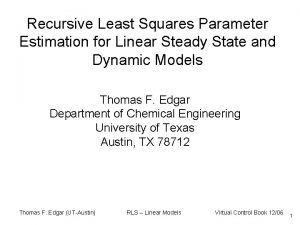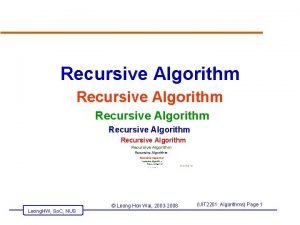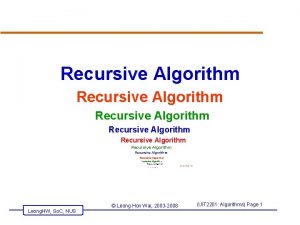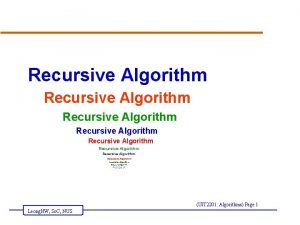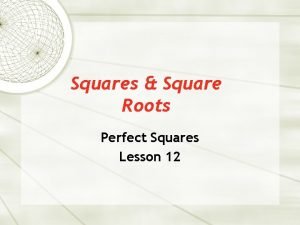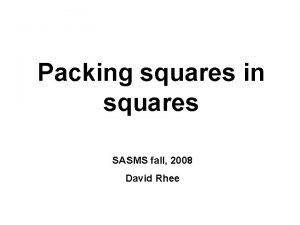9 Recursive Least Squares 1 Recursive identification Suppose


















- Slides: 18

(9) Recursive Least Squares 1

Recursive identification • Suppose, at time instant n, we have a new output value y(n) and we want to calculate θˆ(n). • In off-line or batch identification, the whole data up to time n is used to compute θˆ(n) without exploiting the previous estimate θˆ(n-1). • In this case, the whole computations are repeated every time instant and the computational time and memory storage requirements increase with time as the data size getting larger. • We would like a way of efficiently recalculating the model each time we have new data. 2

General recursive formula • θˆ(n) and θˆ(n− 1) are estimated parameter vector at time n and n − 1, respectively. • ε(n) is the difference between the measured output y(n) and the model output using previous parameter vector θˆ(n − 1). If ε(n) is small, θ(n-1) is good and should not be modified too much. • K(n) is a scaling - also known as the Kalman Gain. 3

Advantages of recursive estimation • Gives an estimate of the model from the first time step. • Computationally more efficient and less memory intensive, especially if we can avoid large matrix inverse calculations. • Ideal for real-time implementations. • Can adapt to changing systems → forms the core of adaptive control and signal processing. 4

Derivation of recursive least squares • In the following we will derive the recursive form of the least squares algorithm by modifying the off-line algorithm. • Let us form the regression matrix and output vector from the data collected up to time n: • The least squares solution is given by 5

Derivation of recursive least squares • Let’s look at the expression for 6

7

Yet we still need a matrix inverse in (6) which is computationally expensive. This can be avoided using the matrix inversion lemma 8

• The matrix inversion lemma is given by • Let us apply the matrix inversion lemma to step (6) • With • The final RLS algorithm becomes 9

Comments • The prediction error εn is the difference between measured output yn and the one-step ahead prediction made at time n − 1: • K n is a weighting factor showing how much the value of εn will modify different elements of the parameter vector. • RLS needs initial values of θ 0ˆand P 0. It is convenient to set θ 0 to zeros and P 0 to LN × I (LN is a large number and I is the identity matrix). 10

Example 1 An input-output data of a certain process is measured as shown in the following Table. Suppose the process can be described by a model If the recursive least squares algorithm is applied for on-line parameter estimation and at time 11

12

RLS with forgetting factor • RLS can be modified to track time-varying parameters of a slowly changing process. For this purpose, consider modifying the least squares loss function to where λ < 1 (e. g. λ = 0. 99 or 0. 95) is called a forgetting factor because older measurements have less effect on the coefficient estimation, hence forgotten. • The smaller the value of λ, the quicker the information in previous data will be forgotten. When λ = 1 this is simply the standard RLS. 13

RLS with forgetting factor 14

Summary of RLS algorithm 1. Initialization: Set na, nb, λ, θ 0 and P 0. Step 2 -5 are repeated starting from t = 1: 2. At time step n = t, measure current output yn. 3. Recall past y’s and u’s and form ϕn. 4. Calculate θn and Pn. 5. θn-1 θn and Pn-1 Pn. 6. t t +1, go to step 2. 15

Example 2 • Consider a system described by where {e(t)} is a white noise sequence with variance 1. • The input u(t) is a uniformly distributed random signal in [2, 2]. • The system parameters are a 1 = − 0. 8, a 2 = 0, b 1 = 1. 0 for the first 500 data samples and then change to a 1 = − 1. 1, a 2 = 0. 3, b 1 = 2. 0 for the next 500 data samples. • Implement the RLS algorithm with forgetting factor to estimate system parameters. Plot the evolution of parameter estimate with λ = 1 and λ = 0. 99. 16

• Evolution of parameter estimates using RLS algorithm ( λ= 1) • Evolution of parameter estimates using RLS algorithm (λ=0. 99) 17

Pseudo-linear regression for ARMAX model • Consider a first order ARMAX system: Where • y(t-1) and u(t-1) are known but e(t-1) is unknown. • We can replace e(t-1) by the prediction error ε(t-1). By this way, the previous RLS algorithm can be employed without modification. • ε 0 can be initialized as 0. 18
 Recursive least squares derivation
Recursive least squares derivation Recursive least squares example
Recursive least squares example How many squares
How many squares Damien thiesson
Damien thiesson Least squares regression line
Least squares regression line Least squares regression line minitab
Least squares regression line minitab Least square solution
Least square solution Continuous least squares approximation
Continuous least squares approximation Segmented least squares dynamic programming
Segmented least squares dynamic programming Linear least squares regression
Linear least squares regression Nonlinear regression lecture notes
Nonlinear regression lecture notes Fit least squares jmp
Fit least squares jmp How to find least squares regression line on statcrunch
How to find least squares regression line on statcrunch State the properties of least square estimators.
State the properties of least square estimators. Least squares example
Least squares example Least squares regression line definition
Least squares regression line definition Qr factorization least squares
Qr factorization least squares Geometry of least squares
Geometry of least squares Heteroskedasticity eviews
Heteroskedasticity eviews
